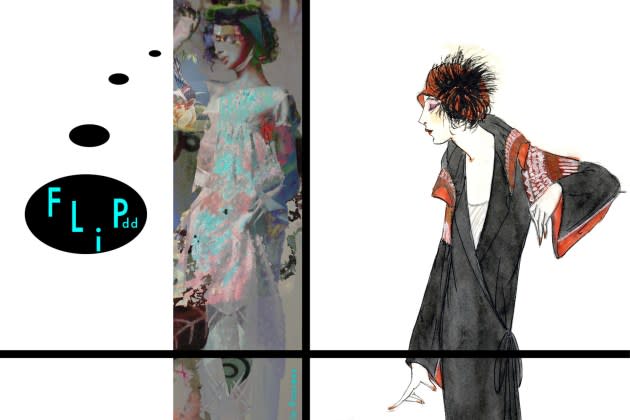FIT Uses AI to Examine Founder’s Past and Explore Students’ Future

Before Max Meyer founded the Fashion Institute of Technology and served as the school’s president, he worked as a buyer for a New York City-based cloak and suit manufacturer in the early decades of the 20th century.
During that time, Meyer commissioned thousands of drawings of French couture designs to be licensed for production Stateside. Now FIT is spinning that interest into a new dimension with “Unconventional Then, Now, & Always: A Helix of FIT Influence from Max Meyer to Daria Dorosh.” Some of the Meyer-sourced watercolor and ink images from Chanel, Poiret, Molyneux, Lanvin, Paquin and other European houses are being juxtaposed with comparable examples of 1920s garments from the study collection of FIT’s graduate program in Fashion and Textile Studies: History, Theory, Museum Practice.
More from WWD
The show is meant to bridge two centuries — one analogue, one digital, expressed through art, fashion, technology, video, and scent created for the project by Gayil Nalls. Fifteen sketches, garments, archival materials and new technology are featured to spark discussions about women, privilege, innovation, the rise of new media and mass entertainment. The two bespoke scents, Hope Water and Forage, will be introduced during the exhibition to enhance the visitor experience.
Meyer’s personal story is a lasting one. In 1890, his family relocated to the U.S. from Alsace, France, partially so that he would avoid compulsory military service in the Prussian army. Improving the marriage prospects of his sisters was also said to be another incentive. After one of his sisters wed Abraham Beller, the owner of Beller & Co., he joined the company at 14, doing menial tasks like sweeping the sidewalk. Over time, his daily responsibilities changed and Meyer became a buyer for the company at the age of 21. In total, he spent 39 years at the company and traveled to Paris 110 times. Meyer considered himself to be one of the first American ready-to-wear manufacturers to order models from couture houses.
To give the show more of a digital allure, passersby on the northwest corner of Seventh Avenue and West 27th Street will see an AI interpretation of a jpeg on a 14.5-foot x 10-foot banner. Noting how the result is an amplification 8,000 times larger than the original image, the show’s co-curator Karen Trivette said, “I really wanted to leverage as much as I could what technology could do. We have moving slide shows 24/7 that feature garments in the show, and manuscript assets in the show that have been extremely enlarged. Sketches that were on 8 x 10 [inch] pieces of paper from the early 1900s have been digitized so that they could be enormously reproduced. So details like the lining of a coat from 1927 are evident, because of the enormity of the upsizing,” she said.

The new exhibition in FIT’s Art and Design Gallery will be open to the public as of Thursday and will remain on view through Sept. 10. For more of a multidimensional spin, a nearby gallery will showcase the contemporary art and fashion pieces of FIT alumna and former FIT Professor Daria Dorosh, PhD. While Meyer “took a unique object and made it for the multiple,” Dorosh, who co-curated the exhibition, “has taken the multiples of mass production — brought on by fast fashion and consumer culture — and brought that back to the unique,“ Trivette said. “She has taken things like a Chanel jacket and married it with a hoodie, creating things that exist nowhere else.”
The upcoming show is a collaboration between the Spatial Experience Design Department, Fashion and Textile Studies: History, Theory, Museum Practice, and the Special Collections and College Archives. As for what Meyer would make of the exhibition, Trivette said, “At the heart of it, he was an educator and a person, who really wanted to elevate the fashion industry in New York City and in America. To do that, he knew he had to appeal to France. Plus, he was a raging Francophile anyway, being from Alsace. But I think he would be pleased — having been such a behind-the-scenes figure to see that this was front and center.”
Some of Meyer’s relatives loaned items for the exhibition and plan to attend the opening. “I know his family is just over-the-moon with this recognition coming at this time, because it’s 100 years after the fact,” Trivette said.
Best of WWD


